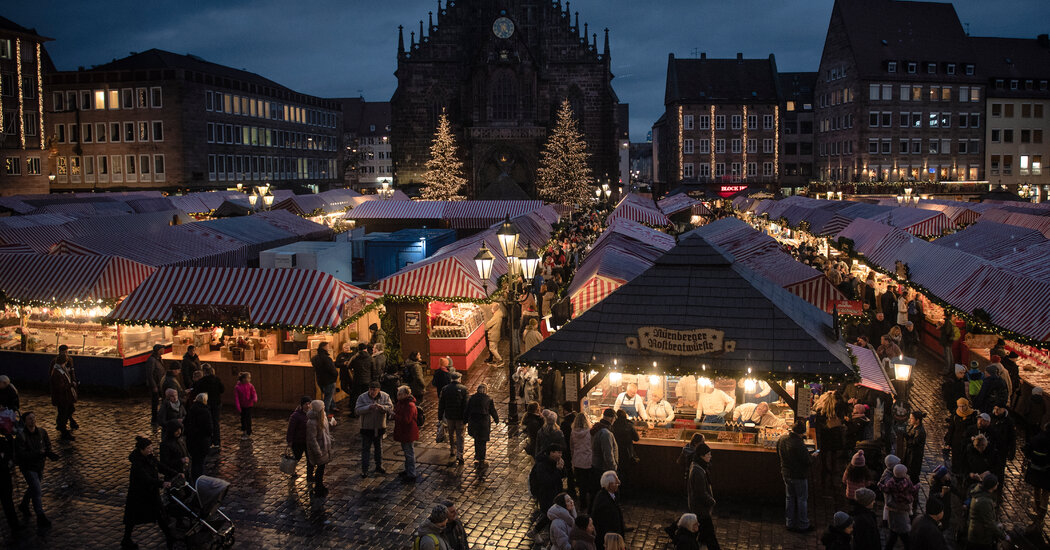|
Getting your Trinity Audio player ready...
|
NUREMBERG, Germany — Nativity scenes carved of wood, ornaments, candles, children’s toys, gingerbread cookies in myriad shapes, sausages and mulled wine sipped in painted glass mugs.
Few places in Germany feel as Christmassy this time of year as the Nuremberg Christkindlesmarkt, one of the oldest and most storied festive markets in the country.
After the Covid pandemic stole two holiday seasons, the red-and-white-roofed booths, rich and spicy odors of treats, and mulled wine-enhanced cheer are back to entice Nurembergers and tourists to a central square in the city again this year. According to city historians, the market has formed annually since at least 1628 (with breaks for the pandemic and for several years right after World War II).
“It’s not really a normal Christmas without the market,” said Ursula Köbl, 73, a local who claims that she never missed the market until 2020, when it was first shut down to prevent the spread of Covid.
But even before this market closes on Christmas Eve at 2 p.m. — as tradition demands — vendors predict that they will not make out as well as they did in 2019. And for the first time in modern history, more than a dozen vendors gave up their prized spots because of high costs and staff shortages, leaving gaps in the lineup of stalls that looked like missing teeth in an otherwise cheerful smile.
Long an integral part of the social calendar, Germany’s roughly 500 Christmas markets have renewed importance as weather vanes of the national mood. Many of them are opening again without any Covid restrictions, but until they opened at the end of November, it remained uncertain whether the economic situation and a looming energy crisis would sour the mood.
Towns and cities across Germany have been darkened because of new energy-saving rules that prohibit the exterior lighting of advertisements, public buildings and even landmarks. Amid the cuts, the markets — tiny temporary villages made up of cloth, wood and strings of (energy-efficient LED) lights — face a challenge to encourage commerce to thrive. First indications suggest, with qualifications, that they are succeeding: While people tend to be spending less at the stalls, the crowds are as big and enthusiastic as ever.
“Many of us missed this market,” said Marcus König, Nuremberg’s mayor. “It’s just a balm for our dented souls after two and a half years of pandemic during which there was very little cultural life.”
The coronavirus has had a detrimental effect on city coffers, which rely on the market, tourism and business travelers who come to the city for trade fairs and congresses, Mr. König explained, adding: “The Christkindlesmarkt is part of Nuremberg’s DNA.”
Read More on the Coronavirus Pandemic
In 2019, the market had 2.2 million visitors who brought in an estimated 180 million euros, about $191 million. The haul is likely to be smaller this year. But despite the fact that the traditional live music stage has been left out this Christmas, the market has been well visited by a mix of enthusiastic Nurembergers and tourists, mostly other Germans and Americans.
“We’ve seen people are really keen to go out and socialize in groups again after the break forced on us by Covid” said Patrick Arens, vice president of a trade association representing vendors at Christmas markets across Germany. Mr. Arens runs a mulled wine stall at the Christmas market in Dortmund.
Ms. Köbl, who was out with friends, cheerfully agreed. “Even when it is this cold, you come out and you mingle and you forget about cold feet,” she said. She noted that she was planning on at least one glass of mulled wine to warm up, even though the price had risen to €4, from €3.50 in 2019.
Kurt Leithner, 80, who helps his daughter run a booth selling dollhouse furniture, said, “I notice people have changed how and what they buy.” Where customers used to pay €30 for a meticulously crafted dollhouse wardrobe, they are now more likely to riffle through smaller items — such as cast-iron typewriters or lamps — that cost less than €5. “There are enough people here, it’s just that one has become more thrifty,” he said.
Ingrid Kiel, who together with her husband helps out at a booth that sells ornate wood decorations, said, “You always need mulled wine and sausage.” Pointing to intricately crafted Nativity scenes that can put discerning customers back nearly €1,000 (most businesses at the market accept credit and debit cards), she said, “But this stuff you don’t actually need to live.”
Two-thirds of Germans told pollsters at the McKinsey consulting firm that they expected inflation to drive consumer goods prices higher, and nearly 60 percent said that increasing prices were currently their main worry. More than half — 53 percent — said that they were planning to save by buying fewer Christmas presents, the survey found, and a minority — 13 percent — said that they would forgo gifts altogether.
But to many Nurembergers, the rising cost of living does not diminish the joy of getting together, of exchanging news and gossip and of living their normal lives.
Even with the electricity crunch brought on by Russia’s attack on Ukraine, Mr. König and other city administrators decided not to pare down this year’s festivities — that is not the case at all the Christmas markets in Germany — leaving the opening hours as 10 a.m. to 9 p.m. The city has been using LED lighting for years, he said, and outdoor heating had been mostly banned since 2008.
A number of rules give the Nuremberg market an old-fashioned vibe. No recorded music is played on the main market, for example, and no items made outside of the Nuremberg region are supposed to be sold (the city acknowledges some leniency on that point). Vendors have to apply in February for a spot. The city’s wait list is usually in the triple digits. (Because vendors are carefully chosen by what goods they sell to maintain a balance, none of those on the list could be used to fill the last-minute gaps this year.) Since 1999, there has been a separate Children’s Christmas market with lower counters and an elaborate merry-go-round.
This year, 20 vendors canceled because of high costs, staff shortages and coronavirus fears, a first in the modern market’s history, according to Marco von Dobschütz-Dietl, who runs the market.
Klaus Schrödel, 59, has been a fixture at the market for three decades, selling traditional zwetschgemännla, good-luck avatars made out of thin wire and prunes. Like many Nurembergers who spend four to five weeks running a stall at the square, he sees the market as his hobby. He and his wife spend the year preparing the odd little keepsakes, and they take time off from their regular jobs to work at the market in December.
“It’s a hobby for me; others travel,” he said. Because his product costs less than €10, he’s doing well, but prices for the fruit he uses as a raw material has doubled, bringing down his margin.
One steady source of sales, even for more expensive goods, has been American tourists, many of whom visit the market on a stopover from river cruises.
On a recent chilly night, Paul Bullock, 50, his wife, Carrie, and friends were in from Austin, Texas, straight off the plane and delighted with the sights and smells. Asked whether they planned to make any major purchases, they conceded that they were ready to be tempted.
“We weren’t planning on buying anything, but I guess we’ll find out if we stick to the plan,” he said, laughing.



